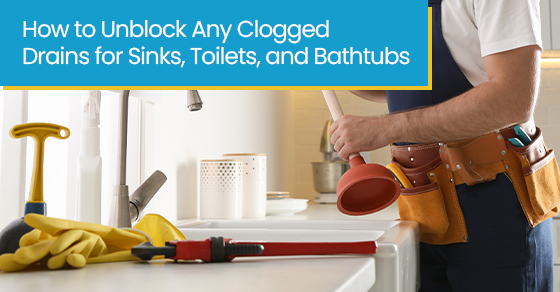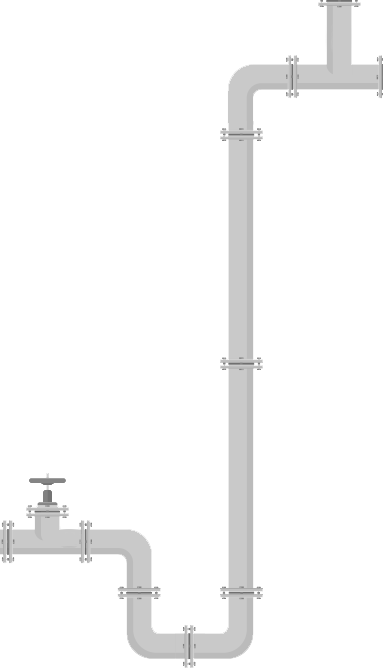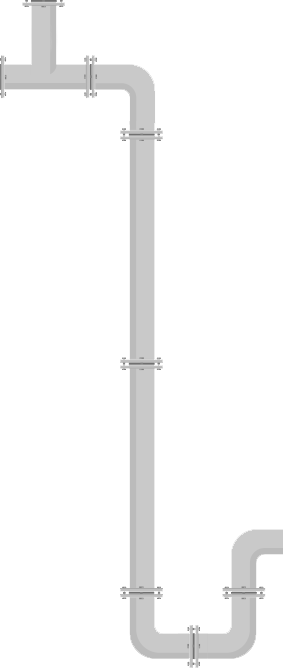How to Unblock Any Clogged Drains for Sinks, Toilets, and Bathtubs
Posted by Jason Genah on 03-11-2023

As a homeowner, you have definitely come across common plumbing problems like leaks, pressure issues, or, more likely, a clogged drain. Every drain in your home has the potential to get clogged.
There are several reasons why a drain could get clogged, but the bottom line is that you should know how to address these issues. While it is better to call a professional in serious cases, some clogs can be fixed with simple tools and some elbow grease.
Before finding out how to unclog any drain, however, it is crucial to understand how the different drains like in the sink, toilet, and bathtub, can become clogged.
What causes clogs?
As often as the drainage system of a house is used, be it the sink, toilet, or tub, it is not uncommon for things to get stuck. If it is the kitchen sink, then food substances that do not break down can get stuck in the drain and cause a blockage.
These products include fibrous foods, grease, oil, and even non-food items. If the sink is clogged, you will notice that the water is not draining as quickly as it used to, or it isn’t draining at all. If this is left unaddressed, it could attract drain flies.
Similarly, the wash basin or bathroom sink and the bathtub drain can get clogged with hair, which is why washing or cutting hair over the sink should be avoided. Soap cannot cause clogs on its own, but when mixed with hair and debris, it can become a clump and lead to a blockage.
If the water stops draining properly, it’s time to unclog your sink. You may feel like fixing it yourself, but we advise getting in touch with one of our professional drain plumbers in Toronto.
Flushing down paper towels or excessive amounts of toilet paper can also clog your toilet drain. Other than the appropriate amount of toilet paper, nothing else should be flushed down the toilet as it could lead to not only clogs but also bad smells and hygiene issues.
How to Unclog Sinks
Both kitchen and bathroom sinks can be unclogged using a wire snake, a plunger, drain cleaning liquid, or even a coat hanger. Starting with the more unorthodox approach, grab a coat hanger, straighten it out as much as possible, and create a hook at one end.
Remove the drain cover (if there is one) and push the hooked end through the drain to fish out whatever might be stuck. Give it a few attempts to remove whatever debris you can, after which you should run some hot water in the drain. Remember that if the job seems too challenging, let our professional drain plumbers in Toronto handle it for you.
Another method is to place a plunger on top of the clogged drain. Make sure that the initial few pumps are more careful and not forced so as to let the air out and create a seal. Then, slowly push down on the plunger, but pull back with some force. This can pull the clog back upward and dislodge it.
For more stubborn clogs, a wire snake or auger will need to be used. It has a flexible metal cable with a corkscrew at the end. Gently feed the cable into the drain, and try to break the clog by wiggling the cable. The clog should break and go down the drain while whatever is stuck to the wire snake can be pulled out and cleaned.
A drain cleaning liquid can also be used in case of minor clogs, as it will dissolve small blockages to clear the drain. It will take some time, but you should note that the drain cleaning liquids can be corrosive, and continuous use can damage the pipes.
How to Unclog the Toilet
Just like any other drain clog, a plunger, auger, or drain cleaning liquid can be used to address clogged toilets. With the plunger, the principle is the same: you should first make sure that the plunger ball is making a tight seal around the drain.
Pump slowly and pull fast to remove the blockage. If it is a small clog, the plunger should help, but for anything stronger, an auger is required.
Augers are long, flexible pipes that can reach deep within the toilet drain to dislodge a clog. Most augers come with hand cranks that allow you to push the internal metal wire deep into the drain.
First, place the curved end of the auger at the entrance of the drain, and then start cranking the handle. You should notice the auger making its way deeper into the drain.
Once it goes in all the way, pull the handle back out; the debris should be stuck on the end of the auger. If you are not sure about using the auger, call our drain plumbers in Toronto to get professional help.
How to Unclog the Bathtub
Just like the sink and toilet, you can unclog your bathtub by using a plunger, drain cleaning liquid, or an auger.
If you are using a drain cleaning liquid, make sure to check if it is safe for pipes. First, remove the drain cover, then remove whatever hair or blockage you can manually before pouring the cleaning liquid.
Leave the drain as is for 15 to 30 minutes—depending on how stubborn you think the clog is—and then run hot water. Furthermore, while using the drain cleaner, make sure to put on gloves and keep the fan on as the smell can linger even after flushing with water.
The plunger and auger will work the same way as with the toilet and sinks. The plunger, though, is more useful in the case of toilets and bathtubs.
Drain Plumber in Toronto: Final Thoughts
There are several ways in which common household clogs can be fixed. In most cases, a plunger should do the trick. However, in case you feel the job is more challenging, contact Drain King Plumbers for the best drain plumber in Toronto. This way, you can sit back and relax while we take care of all your plumbing issues.
For more information about unclogging drains, call Drain King Plumbers at 833-983-5663 or contact us here.




